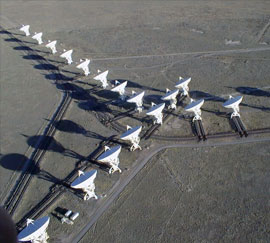Radio
What is a radio wave?

Radio waves have the longest wavelengths in the electromagnetic spectrum. These waves can be longer than a football field or as short as a football. Radio waves do more than just bring music to our radio. They also carry signals for our television and cellular phones.
The antennae on our television set receive the signal, in the form of electromagnetic waves, that is broadcasted from the television station. It is then displayed on our television screen.
Cable companies have antennae or dishes which receive waves broadcasted from our local TV stations. The signal is then sent through a cable to our house.
Cellular phones also use radio waves to transmit information. These waves are much smaller than the TV and FM radio waves.
Radio wave images

Objects in space, such as planets and comets, giant clouds of gas and dust, and stars and galaxies, emit light at many different wavelengths. Some of the light they emit has very large wavelengths, sometimes as long as a mile. These long waves are in the radio region of the electromagnetic spectrum.
Because radio waves are larger than optical waves, radio telescopes work differently than telescopes that we use for visible light (optical telescopes). Radio telescopes are dishes made out of conducting metal that reflect radio waves to a focus point. Because the wavelengths of radio light are so large, a radio telescope must be physically larger than an optical telescope to be able to make images of comparable clarity.
In order to make better and more clear (or higher resolution) radio images, radio astronomers often combine several smaller telescopes, or receiving dishes, into an array. Together, the dishes can act as one large telescope.The Very Large Array (VLA) is one of the world's premier astronomical radio observatories. The VLA consists of 27 antennas arranged in a huge "Y" pattern up to 36 km (22 miles) across - roughly one and a half times the size of Washington, DC.